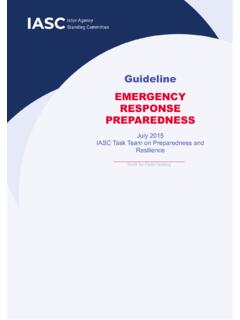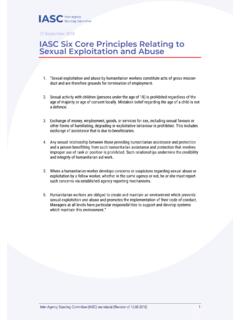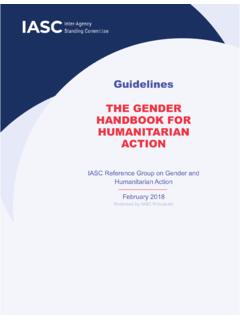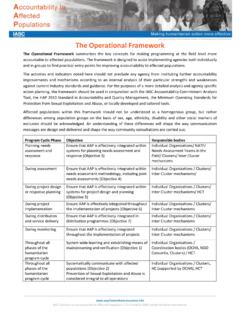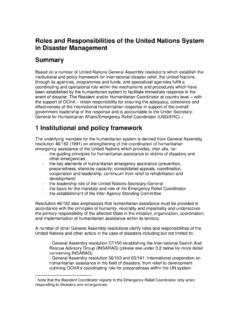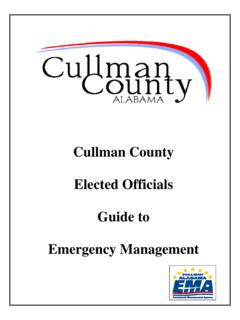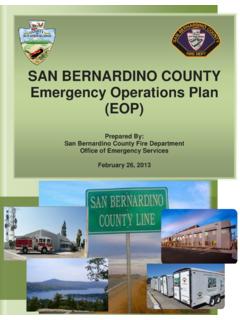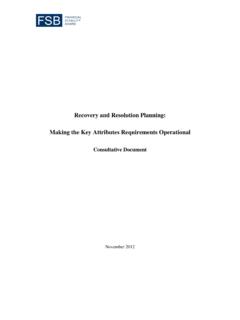Transcription of Handbook for RCs and HCs on Emergency Preparedness and ...
1 Handbook for RCs and HCs on Emergency Preparedness and ResponseHandbook for RCs and HCs on Emergency Preparedness and ResponseThis Handbook was developed by the Inter-Agency Standing Committee (IASC) HC Group. The IASC was established in 1992 in response to United Nations General Assembly resolution 46/182 that called for strengthened coordination of humanitarian assistance. In 1993, the General Assembly, through resolution 48/57, affirmed IASC s role as the primary mechanism for inter-agency coordination of humanitarian assistance. A broad range of UN and non-UN humanitarian partners participate in this Standing Handbook can be downloaded from the IASC website at :http Inter-Agency Standing Committee (IASC) page photos: UN Photo/Tim McKulka Suggested citation :Inter-Agency Standing Committee (IASC) (2010). Handbook for RCs and HCs on Emergency Preparedness and response .
2 Geneva : Handbook and the checklist will be revised and updated on a regular basis. Feedback and comments are therefore welcome, and should be sent to: would like to express its gratitude for the financial support of the European Commission and its Humanitarian Aid and Civil Protection department (ECHO). Handbook for RCs and HCs on Emergency Preparedness and ResponseTable of ContentsINTRODUCTION 1 International humanitarian coordination architecture 1 Guiding principles 4 Accountability 5 Support 5I. DISASTER RISK REDUCTION 71. Lead and coordinate efforts to strengthen country-level commitment to and capacities for disaster risk reduction 7 National Platform for Disaster Risk Reduction 9 Strategic National Action Plan (SNAP) for Disaster Risk Reduction 10 National Matrix of Commitment and Initiatives in support of the HFA 112. Lead and coordinate inter-agency efforts in disaster risk reduction 12 Pool of Disaster Risk Reduction Experts 13 Capacity for Disaster Reduction Initiative (CADRI) 13II.
3 Preparedness 151. Lead and coordinate efforts to strengthen national capacity to respond to emergencies 15 International instruments and guidelines to facilitate international relief 162. Lead and coordinate inter-agency contingency planning 17 Coordination structures for contingency planning 18 Inter-Agency Contingency Plan 18 Security Plan 20 Crisis Management Plan 213. Lead and coordinate Preparedness activities 22 Inter-Agency Simulation Exercise 24 Early Warning-Early Action (EWEA) report 24 Handbook for RCs and HCs on Emergency Preparedness and ResponseIII. response 271. Define a preliminary scenario and alert all partners 27 Global Disaster and Alert Coordination System (GDACS) 28 ReliefWeb 28 Preliminary scenario 282. Ensure adequate response capacity in your office 29UN Disaster Assessment and Coordination (UNDAC) Team 30 Surge capacity 303. Establish and lead humanitarian coordination mechanisms 34 Humanitarian Country Team (HCT) 36 Clusters 37 Thematic groups on cross-cutting issues 43 Early recovery Network 43 Inter-cluster coordination mechanism 44 Security Management Team (SMT) 44 Crisis Management Team (CMT) 454.
4 Lead and coordinate multi-cluster needs assessments 46 Multi-cluster rapid needs assessment 49In-depth sectoral needs assessments and other inter-agency assessments 49 Coordinated situation monitoring 495. Lead and coordinate inter-agency response planning 50 Humanitarian response plan 51 Protection Strategy 52 Early recovery Strategic Framework (ERSF) 526. Lead and coordinate operational response activities 53 International Humanitarian Partnership (IHP) 56 Humanitarian Information Centre (HIC) 57 Foreign Military and Civil Defence Assets (MCDA) 57On-Site Operations Coordination Centre (OSOCC) 58 Virtual On-Site Operations Coordination Centre (VOSOCC) 59 Urban Search and Rescue (USAR) teams 59 Situation report (SitRep) 60 Partnerships with private sector actors 60 Who Does What Where (3W Database) 61 OCHA stockpile 61 Sphere Minimum Standards in Disaster response 61 Handbook for RCs and HCs on Emergency Preparedness and Response7.
5 Mobilize financial resources 62 Appeal mechanisms Flash Appeal 63 Consolidated Appeal Process (CAP) 65 Funding instruments OCHA Emergency Cash Grant 67 UNDP response to Sudden Crisis 68 Central Emergency response Fund (CERF) 70 Country-based Pooled Funds : Emergency response Fund (ERF) 74 Common Humanitarian Fund (CHF) 76 Financial Tracking Service (FTS) 778. Lead and coordinate inter-cluster monitoring and evaluation 78 Monitoring tools 79 Evaluation tools 80 Inter-Agency Real-Time Evaluation (IA RTE) 80 Inter-Agency Joint Evaluation 819. Facilitate humanitarian access 82 International Humanitarian Law (IHL) 84 International instruments and guidelines to facilitate international relief 85 General Assembly resolution 46/182 86 Humanitarian principles 86 Armed or military escorts for humanitarian convoys 87 Negotiation analysis and strategy 8810.
6 Promote the respect of international humanitarian and human rights law 91 Domestic Law 93 Regional Instruments 93 International Law 93 Key protection principles 95 Advocacy strategies 9611. Lead and coordinate efforts against sexual exploitation and abuse 98 Action plan on PSEA 9912. Manage media relations 101Do s and don ts when talking to the press 103 Field Key Messages 103 Media Platforms 103UN Communications Group (UNCG) 104 Handbook for RCs and HCs on Emergency Preparedness and Response13. Lead and coordinate transition from response to recovery 105 Surge capacity for transition to recovery 107 Post-Conflict Needs Assessment and Transitional Results Framework (PCNA-TRF) 107 Post-Disaster Needs Assessment and recovery Framework (PDNA-RF) 108 Phase-down strategy for humanitarian operations 109UN Integrated Strategic Framework (ISF) 110 Peacebuilding Fund for recovery (PBF) 111IV.
7 CROSS-CUTTING ISSUES 113 Age 113 Diversity 113 Environment 114 Gender equality 115 HIV-AIDS 116 Mental health and psychosocial support 117V. ANNEXES 119 Acronyms 119 Resources 122 Index 130 Handbook for RCs and HCs on Emergency Preparedness and ResponseINTRODUCTIONINTRODUCTIONINTRODUC TIONINTRODUCTION1 INTRODUCTIONA bout this handbookThis Handbook outlines the key actions that Resident Coordinators (RCs) and Humanitarian Coordinators (HCs) should take to prepare for and respond to emergencies. It does not aim to replace more in-depth guidance or policy are organized as follows :Chapter title Refers to a task that the RC or HC is accountable is your role ? Summarizes the main actions that need to be taken to accomplish the and how ? Provides a more detailed time frame of the actions to be taken. For additional information on key concepts printed in blue, see the ! Contains tips or important background tools, services or mechanisms to use ?
8 Lists relevant tools, services and mechanisms at the RC s or HC s disposal to perform the necessary to know Lists additional tools that are not for the RC or HC s direct use but are useful to be aware to go for more information Lists key websites and reference document(s). Additional resources can be found in the Annex includes :AcronymsIndex Lists key concepts with a reference to the page(s) where they are Lists useful documents and websites for further referred to in the Handbook can be found in the back humanitarian coordination architectureThe foundations of the current international humanitarian coordination architecture were laid by General Assembly resolution 46/182 of December 1991. The Humanitarian Reform of 2005 introduced a number of new elements to enhance predictability, accountability, and Emergency Relief Coordinator (ERC) has three primary tasks : humanitarian policy development and coordination; advocacy of humanitarian issues and provision of guidance and direction to RCs and HCs.
9 And coordination of international humanitarian Inter-Agency Standing Committee (IASC), chaired by the ERC, is an inter-agency forum for coordination, policy development and decision-making involving the key UN and non-UN humanitarian partners, including United Nations agencies, the International Handbook for RCs and HCs on Emergency Preparedness and Response2 Red Cross and Red Crescent Movement, the International Organization for Migration, non-governmental organizations (NGOs), NGO consortia, and the World , led and coordinated by Clusters Lead Agencies, are IASC-designated groupings of humanitarian organizations (both UN and non-UN) in each of the main sectors of humanitarian action. They operate at both global and country level (although they are not necessarily congruent). At the global level they are responsible for strengthening system-wide Preparedness and coordinating technical capacity to respond to humanitarian emergencies in their respective sector.
10 At the country level clusters ensure that activities of humanitarian organizations are coordinated, serve as a first point of call for the Government and the RC or HC, and as a provider of last resort in their respective Office for the Coordination of Humanitarian Affairs (OCHA), headed by the ERC, is a Department of the UN Secretariat that supports the ERC at the global level and RCs and HCs at the field level by coordinating humanitarian action, advocating for the rights of people in need, developing humanitarian policy and analysis, managing humanitarian information systems, and managing humanitarian pooled funds. OCHA typically supports HCs through a Country Office and RCs through its Regional Offices, and in some cases through a Humanitarian Support Unit in country level, while the primary responsibility for coordinating humanitarian assistance rests with national authorities, if international humanitarian assistance is required the HC or, if a separate HC position is not established, the RC is responsible for leading and coordinating the Preparedness and response efforts of humanitarian organizations (both UN and non-UN), whenever possible in support of and in coordination with national and local authorities.
